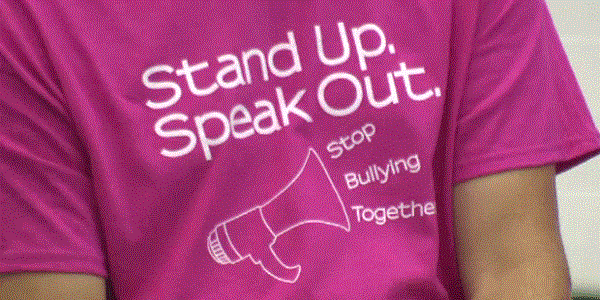
Every year, when the Day of Pink rolls around, I remember my own experience and I wear pink to show my support for International Day Against Bullying.
I admit, I wasn’t bullied as a child. I was lucky. Bullying in the playground can be physical, but it’s really psychological and we’ve all read about the damage it can do. That’s why this campaign is so great because kids will learn that it’s just not cool to be the bully, and they won’t grow up aspiring to be ‘that person’.
When I came across the bullies in my workplace, I didn’t know what was happening. It was only after I left the organization that I started doing some research. My self esteem was low, my emotions shattered and I had to find out what had happened to me. Of course, I was turning the thoughts over and over in my head – what did I do to deserve this?
So I do what helps me the most – I researched and I wrote.
I met other women who had also been bullied. I spoke to experts who had counselled victims. And I also interviewed professionals who revealed, sadly, that bullying was common in the workplace.
But what really helped me the most was understanding the bully, and the motivations behind the actions. Because sometimes through empathy, we find a solution.
Bullies, as the old adage goes, are tormented people themselves. This is true. Most bullies are insecure and hide behind a mask of aggression. The very idea that their flaws could be revealed is too much for the bully. So they find the one who makes them look the worst; the one who shines, and they take on a mission of torment.
The idea behind this strategy is twofold. First, it shows other workers that the bully should be feared. No one would dare point out the bully’s inadequacies. Secondly, once the victim is weakened, their performance collapses, crowning the bully as the winner.
Perhaps you knew this. But at the time, I didn’t. Imagine the look on my face as I sat in the room with two psychologists who stated these conclusions as facts. I was stunned.
Here I was thinking that it was all me. I recalled situations where the meaner the bully was, the nicer I became and the harder I tried. I was being controlled. Nice would never had changed anything, the experts assured me. She just wanted you to feel that you weren’t good enough, even though she knew the opposite. She was actually more afraid of you than you realized, they explained.
So there it was. The profile, in a nutshell, of the workplace bully.
My experience was many years ago and the bully got her wish in the end – she was promoted into my job when I left the organization. In her mind, she won. In my mind, I got out of a bad workplace environment. After all if promotion came through bullying and not performance, what did that say about her supervisor?
This behaviour is rampant in the workplace apparently. And sadly I’ve learned that my story is not unique. Bullies get promoted every day and organizations lose good employees and end up keeping the ones who are simply mediocre – but no one says this out loud, out of fear.
There will always be bullies in the workplace. My strategy on dealing with this behaviour is through my understanding of their motives. So when one crosses my path, I don’t confront the behaviour but simply ignore it. I pick my battles and react calmly only if provoked. But I am not nice. I don’t try and befriend the bully. One thing that’s important to note – bullies want to be liked. So let’s not like them.

